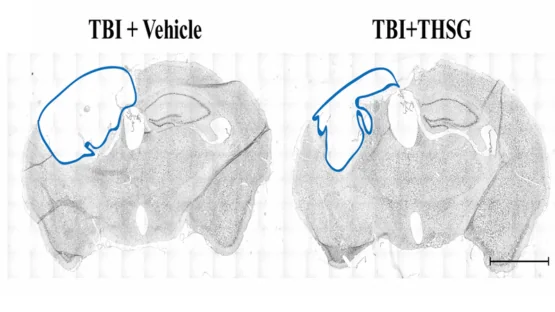Publishing in Aging, a team of Taiwanese researchers has found that a chemical derived from Polygonum multiflorum, a herb native to southeastern China, aids in recovery from traumatic brain injury and encourages brain regeneration.
The problem of glutamate
Traumatic brain injury (TBI), the infliction of tissue damage directly to the brain, causes oxidative stress and inflammation that can lead to further damage [1]. This includes DNA damage, which leads to brain cell death through apoptosis [2].
Prior research has found that some of this damage is caused by elevated, neurotoxic levels of the amino acid glutamate [3], which has been shown to cause cell swelling and death in cell cultures [4]. Other research has found that this is due to its interference with a specific pathway based on N-methyl-D-aspartate (NMDA) [5]. Excess glutamate has also been shown to cause damage to the glial cells, the chaperone cells of the brain [6].
Some research has already revealed that antioxidants may prevent some of this damage [7]. Therefore, the researchers examined 2, 3, 5, 4’-tetrahydroxystilbene-2-O-beta-D-glucoside (THSG), which is derived from the Chinese herb Polygonum multiflorum and is known for its antioxidant properties.
THSG reverses the effects of glutamate
For their first experiment in this study, the researchers administered THSG to glial cells two hours before dosing them with glutamate. They found that 100 micromoles of THSG was the optimal dose; while it had no significant effect on cells that had not been dosed with glutamate, it dramatically increased the viability of cells that were. Higher doses did not help, and the 300-micromole dose appeared to show toxicity.
Similar results were found in cortical neurons. Interestingly, these cells performed better at a 200-micromole dose of THSG, and a 300-micromole dose did not show any toxicity at all..
The researchers then examined a mouse model of TBI, finding consistent results between their tests. Foot slipping on a balance beam test was significantly reduced, neurological severity score was significantly reduced, and testing with an underwater platform-finding task revealed significant amelioration in the THSG group. THSG had no significant effect on uninjured mice.
Perhaps most importantly, 21 days after injury, the THSG-treated mice were shown to recover from traumatic brain injury to a greater extent than the untreated group, both in the foot-slip balance beam test and in a physical examination.
A possibility of regeneration?
As their last experiment, the researchers tested for doublecortin, a protein that is associated with immature neurons and neuronal precursors and that has been shown to improve recovery in children suffering from TBI [8]. While this protein is enhanced after TBI, it was even further enhanced with administration of THSG in mice, suggesting that this compound enhances a natural repair process. Interestingly, THSG administration was shown to substantially enhance doublecortin expression even in uninjured animals.
Conclusion
The researchers conclude their study by highlighting the known roles of apoptosis in brain deterioration and suggesting that THSG be given at a dose of 60 mg/kg in subsequent research. While their focus is on immediate recovery after traumatic injury, it seems plausible that THSG’s effects on neurogenesis might make this compound valuable for spurring neurogenesis and improving memory to help ameliorate age-related diseases, and we look forward to research in this direction.
Literature
[1] Corps, K. N., Roth, T. L., & McGavern, D. B. (2015). Inflammation and neuroprotection in traumatic brain injury. JAMA neurology, 72(3), 355-362.
[2] Smith, J. A., Park, S., Krause, J. S., & Banik, N. L. (2013). Oxidative stress, DNA damage, and the telomeric complex as therapeutic targets in acute neurodegeneration. Neurochemistry international, 62(5), 764-775.
[3] Guerriero, R. M., Giza, C. C., & Rotenberg, A. (2015). Glutamate and GABA imbalance following traumatic brain injury. Current neurology and neuroscience reports, 15(5), 1-11.
[4] Rothman, S. M. (1985). The neurotoxicity of excitatory amino acids is produced by passive chloride influx. Journal of Neuroscience, 5(6), 1483-1489.
[5] Tymianski, M., Charlton, M. P., Carlen, P. L., & Tator, C. H. (1993). Source specificity of early calcium neurotoxicity in cultured embryonic spinal neurons. Journal of Neuroscience, 13(5), 2085-2104.
[6] Matute, C., Domercq, M., & Sánchez-Gómez, M. V. (2006). Glutamate-mediated glial injury: mechanisms and clinical importance. Glia, 53(2), 212-224.
[7] Di Pietro, V., Yakoub, K. M., Caruso, G., Lazzarino, G., Signoretti, S., Barbey, A. K., … & Amorini, A. M. (2020). Antioxidant therapies in traumatic brain injury. Antioxidants, 9(3), 260.
[8] Chiaretti, A., Barone, G., Riccardi, R., Antonelli, A., Pezzotti, P., Genovese, O., … & Conti, G. (2009). NGF, DCX, and NSE upregulation correlates with severity and outcome of head trauma in children. Neurology, 72(7), 609-616.




